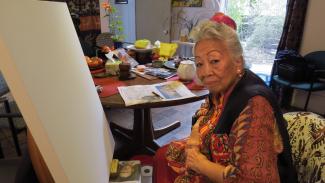The only-child of the world-renowned, expressionist master Affandi (1907 - 1990) and his first wife Maryati, Kartika’s artistic talent was evident at an early age. But her father told her “It is a shame you were born a female and my daughter, because as a woman you will never be able to be accepted as an artist in this country. And if somehow you are, then you will always be cursed as my offspring to live in my shadow.”
She grew up in extreme poverty, as the dying days of the colonial Dutch East Indies gave way to the brutal Japanese occupation during WWII. After the war when the Dutch returned to Java to try to reclaim their empire, her father Affandi supported the struggle for Indonesian independence by painting posters and graffiti rallying the population to revolution. For this her family was interned in a Dutch prison camp.
When the Indonesian revolution succeeded, the visionary leader Soekarno became the Republic of Indonesia’s first President, and he supported Kartika’s father Affandi. But Kartika’s own determination to make a career as an artist was not taken seriously by her family, and at age 17 she was married off to a painter friend of her father’s to become an ‘artist’s wife’ instead. She bore him eight children in ten years but still continued painting, giving her first exhibition at age 23. When her husband finally abandoned her to live with two younger lovers, she became the first woman in the then 30-year history of the Republic of Indonesia to file for divorce.
Over the coming years she raised her children, and despite severe social criticism and financial struggle she continued to paint, and began a lifetime of artistic travel and study. Her struggle as an Indonesian woman artist gave her a natural empathy with the down-trodden everywhere, whether they were beggars or handicapped persons in Java, fishermen in China, peasant farmers in the low countries of Europe, Australian Aboriginals, or even long-suffering, farm animals. She liked to work out in the open, in close contact with the subjects and settings she painted, and she abandoned the paintbrush to directly apply paint to canvas with her bare hands.
Eventually she remarried, this time to an Austrian she met while studying art restoration in Vienna. He returned with her to Java, but after a few years left her to move in with their housekeeper in the house next door to hers. Kartika’s self-portraits during this period depict her bound with barb wire, psychologically tortured, and giving birth to a new, yet wizened and haggard version of her former self. Although she was later to form a deep and long lasting relationship with a dashing Australian architect which continues to the present, she has never remarried.
Kartika is a thoroughly independent Javanese artist and visionary. In a culture where the individual self has traditionally only rarely been put to the fore, Kartika has made the self-portrait one of her main themes. In a society where emotion is suppressed, both publicly and privately, Kartika fills her canvases with intense feeling. In a culture where genitals are considered taboo in representation, Kartika has painted her own and others’ nudity graphically and without any distancing sweetness, never depicting her body merely as an object of pleasure, whether that of others or her own, always including the whole spectrum of life experience in her work. Going against the old Javanese convention that placidity, harmony and beauty of both physical and spiritual kinds be normative for all forms of creative expression, Kartika creates real-life, turbulent and disturbing images.
Kartika’s lack of reticence is unusual for a Javanese woman, particularly of her generation, but even compared to younger women. She has chosen to be at odds with a patriarchal culture in which the body, sexuality, nakedness, and even left-handedness, must be suppressed. Kartika’s work emanates a motherly sensuality, unconstrained by narrow, moral precepts, the fear of how people will interpret or judge her, or any embarrassment about the body’s natural functions. Kartika creates a link in her art and life to a mythology of strong, ancient Javanese female characters like Srikandi which had all but disappeared in the process of colonization and modernization in contemporary Indonesia.
Kartika is the first female artist in Indonesia who has dared to openly express the pain and struggle of a woman in search of her true identity no matter how this might clash with culturally imposed roles of womanhood. Kartika is a vocal champion for the right of women everywhere to pursue independence and careers in the areas of their choice. While she has paid a heavy psychological and social cost for her determination to become an artist and express her particular genius, Kartika’s struggle and triumph, like her art, is inspiring, beautiful and unique.
Extrapolated from writings by Astri Wright, Professor of Southeast Asian Art at University of Victoria, Canada, with the author's permission,
Follow The Kartika Affandi Project on Facebook https://www.facebook.com/kartikadoco/
